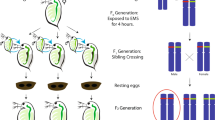Abstract:
To study germ-cell mutagenesis from the viewpoint of biodiversity, we developed a nonmammalian specific-locus test system using the Japanese medaka, Oryzias latipes. The genetic end points available are dominant lethal mutations, total specific-locus mutations, and viable specific-locus mutations. We examined 1,091,824 F1 embryos that correspond to 3,135,999 genetic loci using gamma rays and ethylnitrosourea as mutagens. The results indicated the feasibility of using the medaka test system to detect genotoxic substances in the aquatic environment. The data also indicated the presence of in vivo safeguards against germ-cell mutagenesis. We present a brief summary of our medaka specific-locus test system raising perspectives on its value.
Similar content being viewed by others
Author information
Authors and Affiliations
Additional information
Received January 31, 2001; accepted March 30, 2001
Rights and permissions
About this article
Cite this article
Shima, A., Shimada, A. The Medaka as a Model for Studying Germ-Cell Mutagenesis and Genomic Instability. Mar. Biotechnol. 3 (Suppl 1), S162–S167 (2001). https://doi.org/10.1007/s10126-001-0038-X
Issue Date:
DOI: https://doi.org/10.1007/s10126-001-0038-X




